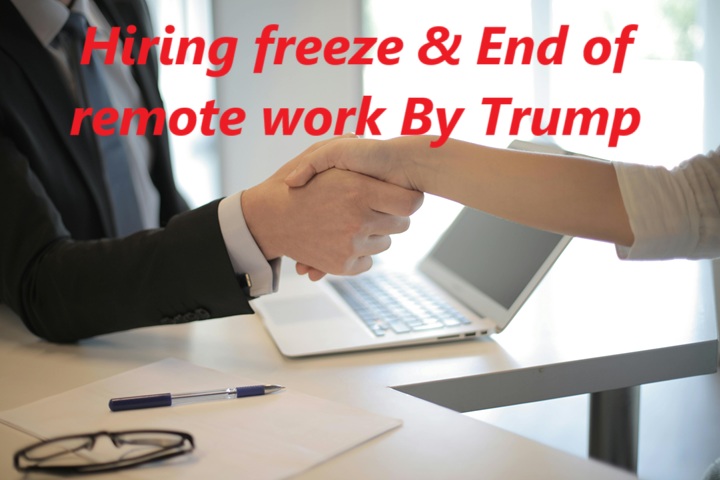Trump’s Executive order – Hiring Freeze & federal worker back to work
In a significant move impacting the federal workforce, former President Donald Trump recently signed executive orders instituting a federal hiring freeze and mandating federal employees to return to their offices full-time. These actions, part of his initial wave of executive orders, aim to streamline government operations and reduce costs—an objective Trump has repeatedly emphasized. Here’s a detailed look at these measures and their implications.
The Federal Hiring Freeze: A Push for Efficiency
Trump’s executive order on the hiring freeze prohibits federal agencies and departments from filling vacant positions. Effective immediately, it directs these entities to focus on “efficient use of existing personnel and funds to improve public services and the delivery of these services.” The hiring freeze excludes roles related to the military, immigration enforcement, national security, or public safety, emphasizing the administration’s prioritization of national interests.
The hiring freeze also outlines a 90-day period for the Office of Management and Budget (OMB), the Office of Personnel Management (OPM), and the Department of Government Efficiency (DOGE) to develop a comprehensive plan to reduce the size of the federal workforce. Trump’s pick to lead the OMB, Russell Vought, is known for his commitment to aggressive cost-cutting and deregulation, reinforcing the administration’s goals of curbing governmental expenses.
While the memorandum emphasizes that the freeze will not override existing collective bargaining agreements, it has already drawn criticism. The American Federation of Government Employees (AFGE) President Everett Kelley described the move as chaotic, arguing that it unfairly targets hardworking federal employees. Kelley’s remarks highlight concerns over potential disruptions to essential services and worker morale.
Mandate for In-Person Work: Ending Remote Flexibility
In a separate but equally impactful memo, Trump directed all federal agencies to end remote work policies “as soon as practicable.” This order requires employees to return to their official duty stations full-time, effectively rolling back the remote work flexibility that many federal workers have enjoyed since the onset of the COVID-19 pandemic.
This decision impacts over 2 million federal employees, making the U.S. government the largest employer in the country. A recent report from the OMB revealed that more than half of the federal workforce currently works remotely, either partially or fully. Proponents argue that returning to in-person work will boost productivity and foster collaboration. However, critics contend that the abrupt transition could lower employee satisfaction and disrupt workflows.
The administration’s stance reflects Trump’s broader skepticism of remote work—an issue he has often linked to decreased accountability and inefficiency. This order has sparked debates about the future of workplace flexibility in government roles, especially given the lasting impacts of remote work on modern employment practices.

Implications for Federal Employees and Operations
Employee Morale and Retention:
The hiring freeze and return-to-office mandate could lead to dissatisfaction among federal workers, potentially increasing turnover rates. Employees accustomed to remote work flexibility may find the sudden change challenging, especially those balancing caregiving responsibilities or health concerns.
Workplace Productivity:
While in-person work may enhance collaboration, it could also reduce efficiency for tasks that can be performed remotely. The transition period may result in temporary disruptions to critical services.
Economic Impact:
Reducing the size of the federal workforce aligns with Trump’s commitment to fiscal conservatism. However, layoffs or unfilled vacancies could ripple through local economies, especially in areas heavily reliant on government jobs.
Service Delivery:
With fewer employees and resources, some federal agencies may struggle to meet public demands effectively. This raises concerns about the quality and timeliness of government services.

Reactions from Stakeholders
The hiring freeze and back-to-office order have sparked varied reactions from different stakeholders:
Government Leaders:
Advocates within the administration argue that these measures will streamline operations and eliminate inefficiencies, aligning with Trump’s promise to “drain the swamp.”
Labor Unions:
Organizations like the AFGE have expressed strong opposition, citing potential harm to employee rights and morale. Union leaders emphasize that federal workers are critical to maintaining essential services.
Policy Experts:
Analysts are divided. Some see the measures as necessary for fiscal discipline, while others warn of the unintended consequences of reduced staffing and workplace rigidity.
A Broader Context: Trump’s Approach to Governance
These executive orders are consistent with Trump’s broader approach to governance, which emphasizes cost-cutting, deregulation, and efficiency. His administration has often portrayed the federal workforce as an overly bureaucratic entity resistant to change. By targeting hiring practices and remote work policies, Trump aims to reshape the federal government to reflect his priorities.
The choice of Elon Musk to lead DOGE—an entity tasked with driving efficiency—also underscores Trump’s unconventional approach. Musk’s background in disruptive innovation suggests a focus on leveraging technology and private-sector principles within government operations.
Future Outlook: Challenges and Opportunities
Challenges:
The abrupt nature of these changes may lead to operational inefficiencies in the short term.
Resistance from employees and unions could result in legal battles or prolonged negotiations.
Opportunities:
If implemented effectively, the hiring freeze and back-to-office mandate could reduce waste and foster a culture of accountability.
Advances in technology could play a crucial role in optimizing government services with fewer resources.
Conclusion
Trump’s hiring freeze and return-to-office mandate represent a bold attempt to reshape the federal workforce. While proponents view these measures as steps toward efficiency and fiscal responsibility, critics highlight potential drawbacks, including reduced morale and service quality. As these policies unfold, their long-term impact on government operations and employee satisfaction will become clearer.
For federal employees and citizens alike, these changes mark a pivotal moment in the ongoing debate about the role and structure of government in a modern, post-pandemic world.
Disclaimer:
The content of this blog is for informational purposes only and does not constitute professional advice. The opinions expressed herein are those of the author and do not necessarily reflect the official views of the federal government or any associated entities. Readers are advised to consult official government communications and trusted resources for detailed information on federal policies and regulations. Author of the blog is not responsible for any decisions made based on the content of this article.


Recent Comments